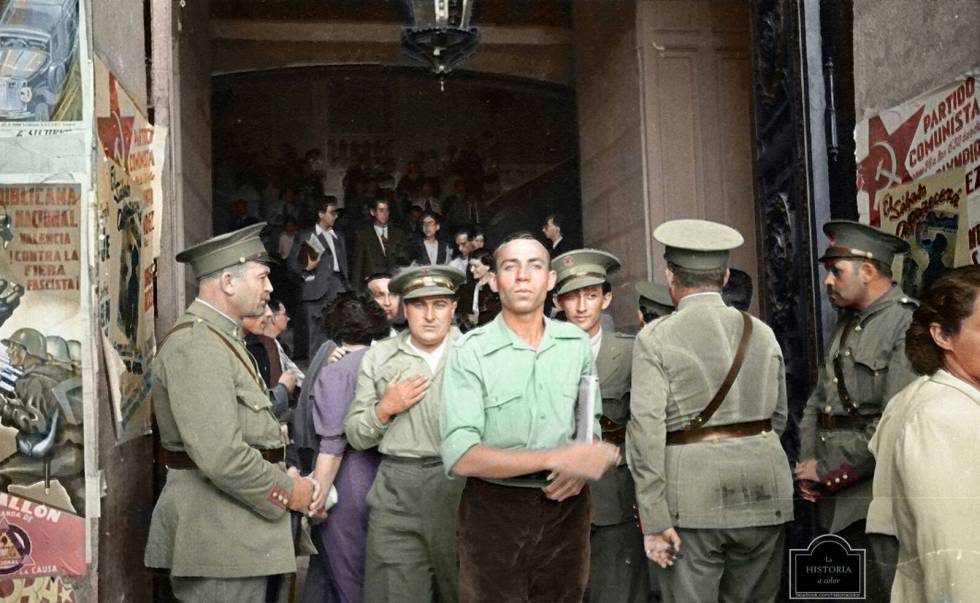
3,000 corrections for the poet Miguel Hernández
A new edition of the writer’s collected works contains 30 never before released poems
Jesús Ruiz Mantilla
23 October 2017
Josefina Manresa, Miguel Hernández’ widow, said her husband liked to imitate nightingales and tell dirty jokes. “The first thing she loved; the second, not so much,” recalls Lucía Izquierdo, the poet’s daughter-in-law who in charge of his legacy. Recently she accompanied professor Jesucristo Riquelme in the presentation of a new edition of the author’s Complete Works (1910–1942), published by Edaf.
It is an exhaustive compilation, with everything he left behind thoroughly edited. The collection includes about 3,000 corrections to his writings, 30 unpublished works of different genres and 50 texts, which are “conspicuously altered from what was previously known,” says Riquelme.
It has taken this professor of language and literature at the University Miguel Hernandez of Elche more than eight years to complete this project, with the help of the publisher Carlos R. Talamás. He has examined the poet’s legacy, retraced his footsteps, and analyzed everything from manuscripts to correspondence.
What remains is this volume of almost 2,000 pages, where his poetry shines along with his war stories, press articles, dramatic works, images and traces of a happy, desolate, and combative biography. “It is about the writer who has turned the poetic word into ethics,” says the person responsible for this exhaustive literary work.
Ambition and passion
From his style reminiscent of the Basque poet Luis de Góngora, to his breakout Perito en Lunas (Expert on moons), Miguel Hernandez’s brilliant journey to the heart of literature lasted a decade. His vitality, ambition, and passion took him to the top of the Generation of ’27, a group of influential Spanish poets.
He was encouraged and supported chiefly by the poet Vicente Aleixandre and received with reservations by the poet Federico García Lorca. He retreated to the mud of the trenches, roused the militiamen, never forgot his peasant origins and hours among herds as a shepherd, and he died sighing for his children in a prison corridor. His belongings at the time of death included: a jumpsuit, two T-shirts, a sweater, a dress shirt, a pair of underpants, two pillowcases, a belt, a towel, a napkin, two handkerchiefs, a pair of socks, a blanket, a pot and a jar.
That is all he had in his jail cell in Alicante, a city in southeastern Spain, when he died on March 28, 1942, 75 years ago. His pages were his more valuable possessions, with poems that offer a full portrait of the man. His life dazzled poet Pablo Neruda. “Few poets are as generous and brilliant as the boy from Orihuela,” said Neruda, about Hernández who came from Orihuela in Alicante province. “The awful, awful beauty of his ingrained heart,” said a captivated Juan Ramón Jiménez, a fellow Spanish poet.
His poetry shines alongside his war stories and dramatic works
But it was Aleixandre who took care of him, guided him and made him great after his death by helping his widow in the postwar years. Josefina Manresa was a constant muse for the poet. But one must not forget the passion he once had for the surrealist painter Maruja Mallo. “Together with her, he discovered a carnal love, an almost orgiastic experience, that marked him tremendously,” said Riquelme. This new edition brings new light to that relationship.
“In many of the poems, the change of a word completely disrupts its meaning. We have verified errors involving draft revisions,” adds Riquelme about his editing. He has had a great deal of time and access to the poet’s work but gaps remain, like a collection of letters. “It's still early. We constantly receive unpublished letters from different archives. While finishing up this project, we will have received about 100 new letters. The collected letters is underway, but it must be dealt with carefully.”
For now, this new collection replaces the other two editions of Hernández’ complete works. This new volume also includes an archive of images with photographs, documents and originals. “These are keys for reading the book, and they are important as many of the texts,” Riquelme concludes.


No comments:
Post a Comment